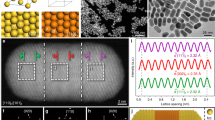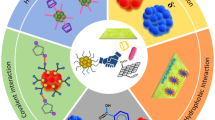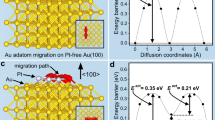Abstract
Gold (Au) nanomaterials have attracted wide research attention, owing to their high chemical stability, promising catalytic properties, excellent biocompatibility, unique electronic structure and outstanding localized surface plasmon resonance (LSPR) absorption properties; all of which are closely related to their size and shape. Recently, crystal-phase-controlled synthesis of noble metal nanomaterials has emerged as a promising strategy to tune their physicochemical properties. This protocol describes the detailed experimental procedures for the crystal-phase-controlled syntheses of Au nanomaterials with unusual crystal structures under mild conditions. Briefly, pure hexagonal close-packed (hcp) Au square sheets (AuSSs) with a thickness of ∼2.4 nm are synthesized using a graphene-oxide-assisted method in which HAuCl4 is reduced by oleylamine in a mixture of hexane and ethanol. By using pure hexane as the solvent, well-dispersed ultrathin hcp/face-centered cubic (fcc) Au nanowires with a diameter of ∼1.6 nm on graphene oxide can be obtained. Meanwhile, hcp/fcc Au square-like plates with a side length of 200–400 nm are prepared via the secondary growth of Au on the hcp AuSSs. Remarkably, hexagonal (4H) Au nanoribbons with a thickness of 2.0–6.0 nm can be synthesized with a one-pot colloidal method in which HAuCl4 is reduced by oleylamine in a mixed solvent of hexane and 1,2-dichloropropane. It takes 17–37 h for the synthesis of these Au nanomaterials with unusual crystal structures. Transmission electron microscopy (TEM) and atomic force microscopy (AFM) are used to characterize the resultant Au nanomaterials, which could have many promising applications, such as biosensing, near-IR photothermal therapy, catalysis and surface-enhanced Raman scattering (SERS).
This is a preview of subscription content, access via your institution
Access options
Access Nature and 54 other Nature Portfolio journals
Get Nature+, our best-value online-access subscription
$29.99 / 30 days
cancel any time
Subscribe to this journal
Receive 12 print issues and online access
$259.00 per year
only $21.58 per issue
Buy this article
- Purchase on Springer Link
- Instant access to full article PDF
Prices may be subject to local taxes which are calculated during checkout







Similar content being viewed by others
References
Anker, J.N. et al. Biosensing with plasmonic nanosensors. Nat. Mater. 7, 442–453 (2008).
Lee, S.-W. et al. Highly sensitive biosensing using arrays of plasmonic Au nanodisks realized by nanoimprint lithography. ACS Nano 5, 897–904 (2011).
Yavuz, M.S. et al. Gold nanocages covered by smart polymers for controlled release with near-infrared light. Nat. Mater. 8, 935–939 (2009).
Huang, X., El-Sayed, I.H., Qian, W. & El-Sayed, M.A. Cancer cell imaging and photothermal therapy in the near-infrared region by using gold nanorods. J. Am. Chem. Soc. 128, 2115–2120 (2006).
Huang, X. et al. Freestanding palladium nanosheets with plasmonic and catalytic properties. Nat. Nanotech. 6, 28–32 (2011).
Fujita, T. et al. Atomic origins of the high catalytic activity of nanoporous gold. Nat. Mater. 11, 775–780 (2012).
Novo, C., Funston, A.M. & Mulvaney, P. Direct observation of chemical reactions on single gold nanocrystals using surface plasmon spectroscopy. Nat. Nanotech. 3, 598–602 (2008).
Zhou, X. et al. Quantitative super-resolution imaging uncovers reactivity patterns on single nanocatalysts. Nat. Nanotech. 7, 237–241 (2012).
Chen, C. et al. Highly crystalline multimetallic nanoframes with three-dimensional electrocatalytic surfaces. Science 343, 1339–1343 (2014).
Tian, N., Zhou, Z.-Y., Sun, S.-G., Ding, Y. & Wang, Z.L. Synthesis of tetrahexahedral platinum nanocrystals with high-index facets and high electro-oxidation activity. Science 316, 732–735 (2007).
Li, J.F. et al. Shell-isolated nanoparticle-enhanced Raman spectroscopy. Nature 464, 392–395 (2010).
Lu, G. et al. Surface enhanced Raman scattering of Ag or Au nanoparticle-decorated reduced graphene oxide for detection of aromatic molecules. Chem. Sci. 2, 1817–1821 (2011).
Linic, S., Christopher, P. & Ingram, D.B. Plasmonic-metal nanostructures for efficient conversion of solar to chemical energy. Nat. Mater. 10, 911–921 (2011).
Xia, Y., Xiong, Y., Lim, B. & Skrabalak, S.E. Shape-controlled synthesis of metal nanocrystals: simple chemistry meets complex physics? Angew. Chem. Int. Ed. Engl. 48, 60–103 (2009).
Daniel, M.-C. & Astruc, D. Gold nanoparticles: assembly, supramolecular chemistry, quantum-size-related properties, and applications toward biology, catalysis, and nanotechnology. Chem. Rev. 104, 293–346 (2004).
Faraday, M. The Bakerian Lecture: experimental relations of gold (and other metals) to light. Phil. Trans. R. Soc. Lond. 147, 145–181 (1857).
Jana, N.R., Gearheart, L. & Murphy, C.J. Seeding growth for size control of 540 nm diameter gold nanoparticles. Langmuir 17, 6782–6786 (2001).
Nikoobakht, B. & El-Sayed, M.A. Preparation and growth mechanism of gold nanorods (NRs) using seed-mediated growth method. Chem. Mater. 15, 1957–1962 (2003).
Jana, N.R., Gearheart, L. & Murphy, C.J. Wet chemical synthesis of high aspect ratio cylindrical gold nanorods. J. Phys. Chem. B 105, 4065–4067 (2001).
Masuda, H. & Fukuda, K. Ordered metal nanohole arrays made by a two-step replication of honeycomb structures of anodic alumina. Science 268, 1466–1468 (1995).
Brust, M., Walker, M., Bethell, D., Schiffrin, D.J. & Whyman, R. Synthesis of thiol-derivatised gold nanoparticles in a two-phase liquid-liquid system. J. Chem. Soc. Chem. Commun. 801–802 (1994).
Esumi, K., Matsuhisa, K. & Torigoe, K. Preparation of rodlike gold particles by UV irradiation using cationic micelles as a template. Langmuir 11, 3285–3287 (1995).
Sun, Y. & Xia, Y. Shape-controlled synthesis of gold and silver nanoparticles. Science 298, 2176–2179 (2002).
Skrabalak, S.E., Au, L., Li, X. & Xia, Y. Facile synthesis of Ag nanocubes and Au nanocages. Nat. Protoc. 2, 2182–2190 (2007).
Halder, A. & Ravishankar, N. Ultrafine single-crystalline gold nanowire arrays by oriented attachment. Adv. Mater. 19, 1854–1858 (2007).
Lu, X., Yavuz, M.S., Tuan, H.-Y., Korgel, B.A. & Xia, Y. Ultrathin gold nanowires can be obtained by reducing polymeric strands of oleylamine—AuCl complexes formed via aurophilic interaction. J. Am. Chem. Soc. 130, 8900–8901 (2008).
Wang, C., Hu, Y., Lieber, C.M. & Sun, S. Ultrathin Au nanowires and their transport properties. J. Am. Chem. Soc. 130, 8902–8903 (2008).
Huo, Z., Tsung, C.-k., Huang, W., Zhang, X. & Yang, P. Sub-two nanometer single crystal Au nanowires. Nano Lett. 8, 2041–2044 (2008).
Brown, S., Sarikaya, M. & Johnson, E. A genetic analysis of crystal growth. J. Mol. Biol. 299, 725–735 (2000).
Millstone, J.E. et al. Observation of a quadrupole plasmon mode for a colloidal solution of gold nanoprisms. J. Am. Chem. Soc. 127, 5312–5313 (2005).
Ah, C.S. et al. Size-controlled synthesis of machinable single crystalline gold nanoplates. Chem. Mater. 17, 5558–5561 (2005).
Niu, J. et al. Novel polymer-free iridescent lamellar hydrogel for two-dimensional confined growth of ultrathin gold membranes. Nat. Commun. 5, 3313 (2014).
Wang, L. et al. Two-dimensional gold nanostructures with high activity for selective oxidation of carbon–hydrogen bonds. Nat. Commun. 6, 6957 (2015).
Yamamoto, M., Kashiwagi, Y., Sakata, T., Mori, H. & Nakamoto, M. Synthesis and morphology of star-shaped gold nanoplates protected by poly(n-vinyl-2-pyrrolidone). Chem. Mater. 17, 5391–5393 (2005).
Huang, X. et al. Photochemically controlled synthesis of anisotropic Au nanostructures: platelet-like Au nanorods and six-star Au nanoparticles. ACS Nano 4, 6196–6202 (2010).
Chen, S., Wang, Z.L., Ballato, J., Foulger, S.H. & Carroll, D.L. Monopod, bipod, tripod, and tetrapod gold nanocrystals. J. Am. Chem. Soc. 125, 16186–16187 (2003).
Zhang, J. et al. Sonochemical formation of single-crystalline gold nanobelts. Angew. Chem. Int. Ed. Engl. 45, 1116–1119 (2006).
Kim, F., Connor, S., Song, H., Kuykendall, T. & Yang, P. Platonic gold nanocrystals. Angew. Chem. Int. Ed. Engl. 116, 3759–3763 (2004).
Ma, Y. et al. Synthesis of trisoctahedral gold nanocrystals with exposed high-index facets by a facile chemical method. Angew. Chem. Int. Ed. Engl. 47, 8901–8904 (2008).
Ming, T. et al. Growth of tetrahexahedral gold nanocrystals with high-index facets. J. Am. Chem. Soc. 131, 16350–16351 (2009).
Niu, W., Zhang, W., Firdoz, S. & Lu, X. Dodecahedral gold nanocrystals: the missing platonic shape. J. Am. Chem. Soc. 136, 3010–3012 (2014).
Zhang, J. et al. Concave cubic gold nanocrystals with high-index facets. J. Am. Chem. Soc. 132, 14012–14014 (2010).
Fan, Z. & Zhang, H. Crystal phase-controlled synthesis, properties and applications of noble metal nanomaterials. Chem. Soc. Rev. 45, 63–82 (2016).
Zhang, S., Guo, S., Zhu, H., Su, D. & Sun, S. Structure-induced enhancement in electrooxidation of trimetallic FePtAu nanoparticles. J. Am. Chem. Soc. 134, 5060–5063 (2012).
Li, Q. et al. New approach to fully ordered fct-FePt nanoparticles for much enhanced electrocatalysis in acid. Nano Lett. 15, 2468–2473 (2015).
Wang, D. et al. Structurally ordered intermetallic platinum–cobalt core–shell nanoparticles with enhanced activity and stability as oxygen reduction electrocatalysts. Nat. Mater. 12, 81–87 (2013).
Sun, S., Murray, C.B., Weller, D., Folks, L. & Moser, A. Monodisperse FePt nanoparticles and ferromagnetic FePt nanocrystal superlattices. Science 287, 1989–1992 (2000).
Kim, J., Lee, Y. & Sun, S. Structurally ordered FePt nanoparticles and their enhanced catalysis for oxygen reduction reaction. J. Am. Chem. Soc. 132, 4996–4997 (2010).
Ye, H. et al. Ru nanoframes with an fcc structure and enhanced catalytic properties. Nano Lett. 16, 2812–2817 (2016).
Chakraborty, I., Shirodkar, N.S., Gohil, S., Waghmare, V.U. & Ayyub, P. A stable, quasi-2D modification of silver: optical, electronic, vibrational and mechanical properties, and first principles calculations. J. Phys. Condens. Matter 26, 025402 (2014).
Koski, K.J. et al. Structural distortions in 5-10 nm silver nanoparticles under high pressure. Phys. Rev. B 78, 165410 (2008).
Sun, Y., Yang, W., Ren, Y., Wang, L. & Lei, C. Multiple-step phase transformation in silver nanoplates under high pressure. Small 7, 606–611 (2011).
Taneja, P., Banerjee, R., Ayyub, P. & Dey, G.K. Observation of a hexagonal (4H) phase in nanocrystalline silver. Phys. Rev. B 64, 033405 (2001).
Liu, X., Luo, J. & Zhu, J. Size effect on the crystal structure of silver nanowires. Nano Lett. 6, 408–412 (2006).
Sun, Y. et al. Ambient-stable tetragonal phase in silver nanostructures. Nat. Commun. 3, 971 (2012).
Kusada, K. et al. Discovery of face-centered-cubic ruthenium nanoparticles: facile size-controlled synthesis using the chemical reduction method. J. Am. Chem. Soc. 135, 5493–5496 (2013).
Duan, H. et al. Ultrathin rhodium nanosheets. Nat. Commun. 5, 3093 (2014).
Huang, X. et al. Graphene oxide-templated synthesis of ultrathin or tadpole-shaped Au nanowires with alternating hcp and fcc domains. Adv. Mater. 24, 979–983 (2012).
Huang, X. et al. Synthesis of gold square-like plates from ultrathin gold square sheets: the evolution of structure phase and shape. Angew. Chem. Int. Ed. Engl. 50, 12245–12248 (2011).
Fan, Z. et al. Stabilization of 4H hexagonal phase in gold nanoribbons. Nat. Commun. 6, 7684 (2015).
Huang, X. et al. Synthesis of hexagonal close-packed gold nanostructures. Nat. Commun. 2, 292 (2011).
Fan, Z. et al. Surface modification-induced phase transformation of hexagonal close-packed gold square sheets. Nat. Commun. 6, 6571 (2015).
Fan, Z. et al. Epitaxial growth of unusual 4H hexagonal Ir, Rh, Os, Ru and Cu nanostructures on 4H Au nanoribbons. Chem. Sci. 8, 795–799 (2017).
Fan, Z. et al. Synthesis of 4H/fcc Noble multimetallic nanoribbons for electrocatalytic hydrogen evolution reaction. J. Am. Chem. Soc. 138, 1414–1419 (2016).
Beeram, S.R. & Zamborini, F.P. Purification of gold nanoplates grown directly on surfaces for enhanced localized surface plasmon resonance biosensing. ACS Nano 4, 3633–3646 (2010).
Haruta, M., Yamada, N., Kobayashi, T. & Iijima, S. Gold catalysts prepared by coprecipitation for low-temperature oxidation of hydrogen and of carbon monoxide. J. Catal. 115, 301–309 (1989).
Zhu, H., Ke, X., Yang, X., Sarina, S. & Liu, H. Reduction of nitroaromatic compounds on supported gold nanoparticles by visible and ultraviolet light. Angew. Chem. Int. Ed. Engl. 49, 9657–9661 (2010).
Xiong, Z., Zhang, L.L., Ma, J. & Zhao, X.S. Photocatalytic degradation of dyes over graphene-gold nanocomposites under visible light irradiation. Chem. Commun. 46, 6099–6101 (2010).
Viarbitskaya, S. et al. Tailoring and imaging the plasmonic local density of states in crystalline nanoprisms. Nat. Mater. 12, 426–432 (2013).
Hrelescu, C. et al. Selective excitation of individual plasmonic hotspots at the tips of single gold nanostars. Nano Lett. 11, 402–407 (2011).
Longmire, M., Choyke, P.L. & Kobayashi, H. Clearance properties of nano-sized particles and molecules as imaging agents: considerations and caveats. Nano Med. 3, 703–717 (2008).
Huang, X., Qi, X., Boey, F. & Zhang, H. Graphene-based composites. Chem. Soc. Rev. 41, 666–686 (2012).
Zhou, X. et al. In situ synthesis of metal nanoparticles on single-layer graphene oxide and reduced graphene oxide surfaces. J. Phys. Chem. C 113, 10842–10846 (2009).
Acknowledgements
This work was supported by the Singapore Ministry of Education (MOE) under Academic Research Fund (AcRF) Tier 2 (ARC 19/15, MOE2014-T2-2-093; MOE2015-T2-2-057; MOE2016-T2-2-103) and AcRF Tier 1 (2016-T1-001-147; 2016-T1-002-051), and by Nanyang Technological University (NTU) under a Start-Up Grant (M4081296.070.500000) in Singapore. It was also supported by the Joint Research Fund for Overseas Chinese, Hong Kong and Macao Scholars (51528201), the National Natural Science Foundation of China (51322202). We acknowledge the Facility for Analysis, Characterization, Testing and Simulation, Nanyang Technological University, Singapore, for use of its electron microscopy facilities.
Author information
Authors and Affiliations
Contributions
H.Z. proposed the research direction and guided the project. Z.F., X.H. and H.Z. developed the protocol. Z.F. and X.H. performed the experiments. Z.F., X.H., Y.C., W.H. and H.Z. drafted the manuscript. Y.C. performed some supporting experiments. All authors contributed to the manuscript.
Corresponding author
Ethics declarations
Competing interests
The authors declare no competing financial interests.
Rights and permissions
About this article
Cite this article
Fan, Z., Huang, X., Chen, Y. et al. Facile synthesis of gold nanomaterials with unusual crystal structures. Nat Protoc 12, 2367–2376 (2017). https://doi.org/10.1038/nprot.2017.097
Published:
Issue Date:
DOI: https://doi.org/10.1038/nprot.2017.097
This article is cited by
-
Crystal phase engineering of electrocatalysts for energy conversions
Nano Research (2022)
-
Hard nanocrystalline gold materials prepared via high-pressure phase transformation
Nano Research (2022)
-
Facile synthesis and properties of CdSe-poly(arylene ether ketone) nanohybrid materials
Journal of Sol-Gel Science and Technology (2022)
-
Nanocomposites prepared from gold nanowires and multiwalled carbon nanotubes for non-enzymatic sensitive bioelectrochemical detection of pentraxin-3 in human serum
Ionics (2021)
-
Ion irradiation induced phase transformation in gold nanocrystalline films
Scientific Reports (2020)
Comments
By submitting a comment you agree to abide by our Terms and Community Guidelines. If you find something abusive or that does not comply with our terms or guidelines please flag it as inappropriate.



